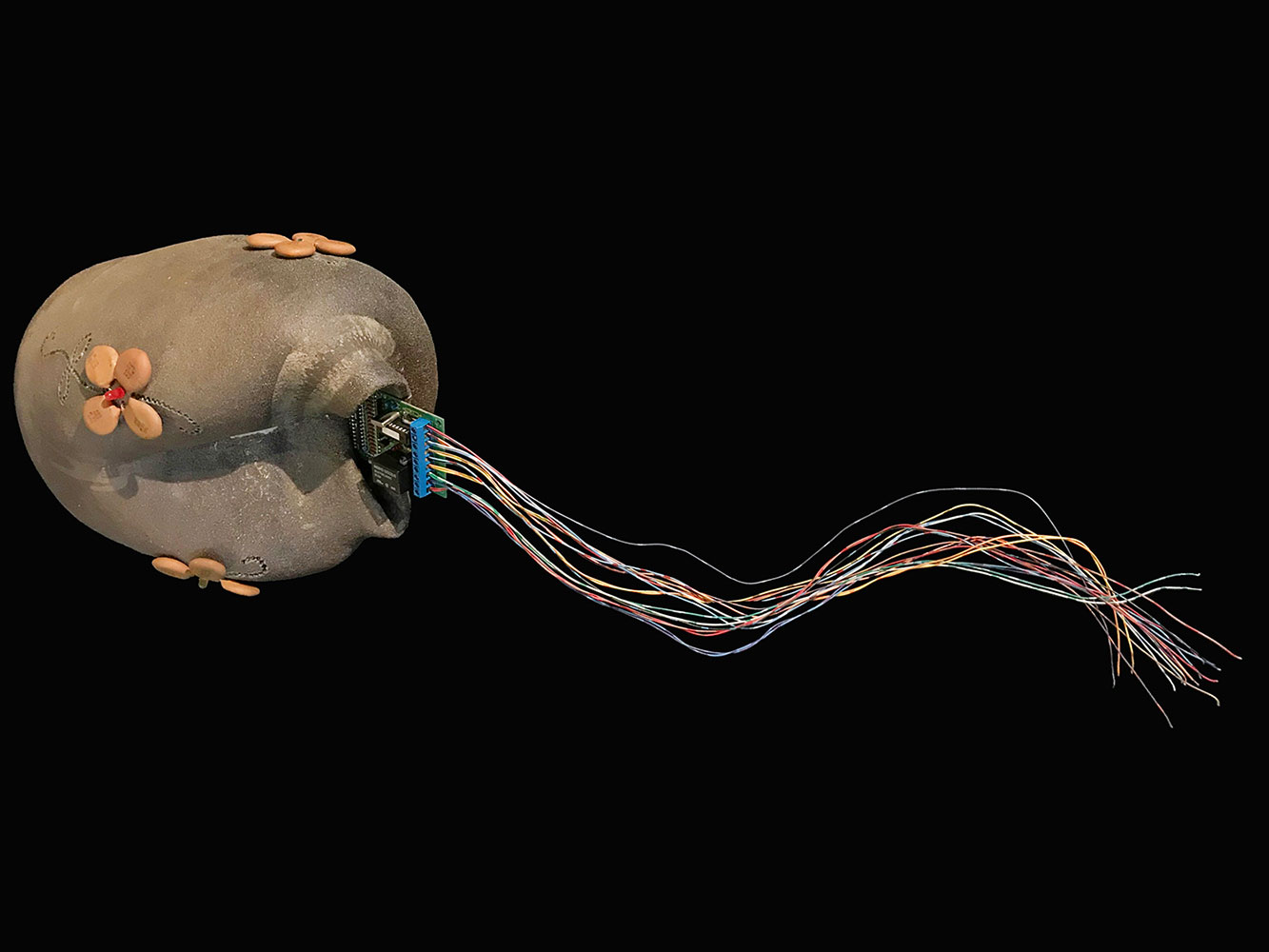In the summer of 2018, Ace undertook a residency in M’Chigeeng First Nation with master Anishinaabe potter David Migwans. David learned to hand-make pottery without a wheel and further developed and refined his pottery techniques working along side his late cousin and artist Carl Beam. Reigniting his interest in pottery years after his ceramic studies at the Kooteney School of Art, Beam focused on southwest pueblo pottery, in particular Santa Clara pottery and Anasazi mimbres bowls, while living in Santa Fe, New Mexico with his wife and artist Ann Beam. Upon their return to M’Chigeeng in the early 1980s, Carl and Ann along with David developed a prolific body of painted pottery works. Working exclusively with locally sourced clay from Manitoulin and surrounding area, they experimented with different firing techniques and additives such as sand, minerals and other materials to give the clay strength, texture, colour, refractive qualities and to abate shrinkage. Decoration of the pottery included mineral and slip based natural paints and hematite polished surfaces in lieu of commercial paints and glazes.
The premise for Ace’s residency was to examine the work of a specific Anishinaabe artist represented in the Ojibwe Cultural Foundation’s art collection and then to work with them to study process and learn technique in the creation of new works that incorporate an intervention of Ace’s electronic component work. As a maker himself, Ace has always been impressed with the masterworks of artist David Migwans. Working both at David’s outdoor home studio and at the newly installed pottery studios at the Ojibwe Cultural Foundation, Ace worked intensively with David Migwans to create several new innovative pots. Transforming functional pottery in to abstracted sculptural forms, Ace vitrified several of these pots. Vitrification is the formation of glass that is accomplished through the literal melting of crystalline silicate compounds into the amorphous, noncrystalline atomic structure associated with glass. As the formed clay works are heated in the kiln, the clay turns into progressively larger amounts of glass. Vitrification in an outdoor kiln is very difficult, due to the shifting levels of temperature from firing the kiln with wood, and this heightens the probability of the material shattering under the intense heat.
The importance of traditional-based learning environments and mentorship is unequivocally imperative to the art of learning to make. It is only through an exchange of traditional knowledge, shared culture-based experience and collective memory that we are able to truly define cultural continuity, as demonstrable through the longstanding confluence between the historical and contemporary of our deeply rooted and ancient Anishinaabeg traditions. For Ace, the experience of working with David Migwans is a profoundly moving one, on so many levels. But perhaps equally profound is the literal connection as a maker with clay drawn directly from our traditional homeland and the shaping of that earth into something tangible and meaningful, as a sovereign act of being Anishinaabe.
The artist gratefully acknowledges the generous support of the Canada Council for the Arts.
Season 2 of Future History on Aboriginal Peoples Television Network (APTN); Episode 3 REBUILD was filmed during the summer of 2018 and features a segment on the Ojibwe Cultural Foundation (OCF), M’Chigeeng, Odawa Mnis (Manitoulin Island). The segment includes an interview with Anong Beam, artist and Executive Director (OCF) and an interview with artist Barry Ace while featuring some of his pottery work.
The REBUILD Episode 3 aired May 28, 2019. (Teaser).

 Barry Ace and David Migwans
Barry Ace and David Migwans  David Migwans sourcing local clay
David Migwans sourcing local clay  Barry Ace sourcing local clay
Barry Ace sourcing local clay  Dried clay (Image: David Migwans)
Dried clay (Image: David Migwans)  Drying clay (Image: David Migwans)
Drying clay (Image: David Migwans)  David’s kiln
David’s kiln  Barry Ace forming clay pot
Barry Ace forming clay pot  Barry Ace forming clay pot
Barry Ace forming clay pot  Barry Ace forming clay pot
Barry Ace forming clay pot  Barry Ace forming clay pot
Barry Ace forming clay pot  Barry Ace forming clay pot
Barry Ace forming clay pot  Barry Ace forming clay pot
Barry Ace forming clay pot  Barry Ace forming clay pot
Barry Ace forming clay pot  Barry Ace forming clay pot
Barry Ace forming clay pot  Barry Ace forming clay pot
Barry Ace forming clay pot  Barry Ace 2018 residency with David Migwans
Barry Ace 2018 residency with David Migwans  Ace adding electronic components
Ace adding electronic components  Ace adding electronic components
Ace adding electronic components  Clay pot and circuit board lid
Clay pot and circuit board lid  Clay pot and circuit board lid
Clay pot and circuit board lid  Removing circuit components for firing
Removing circuit components for firing  Adding coils in making of pot
Adding coils in making of pot  Adding coils in making of pot
Adding coils in making of pot  Fully formed clay pot
Fully formed clay pot  David Migwans – Gathering Birch Bark (1994)
David Migwans – Gathering Birch Bark (1994)  Transformer (2018) 24.1 x 20.3 x 53.3 cm, mixed media. Collection of the Artist.
Transformer (2018) 24.1 x 20.3 x 53.3 cm, mixed media. Collection of the Artist.  Transformer detail (2018) 69 (l) x 17.5 (h) x 20 (d) cm, mixed media. Collection of the Artist.
Transformer detail (2018) 69 (l) x 17.5 (h) x 20 (d) cm, mixed media. Collection of the Artist.  Nest (2018) 17 (l) x 9 (h) x 21 (d) cm, mixed media. Available for Purchase at LA PAI (Ottawa).
Nest (2018) 17 (l) x 9 (h) x 21 (d) cm, mixed media. Available for Purchase at LA PAI (Ottawa).